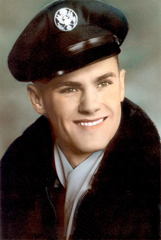

Wesley was inducted into the Air Force on December 27, 1950. He trained at Lackland Air Force Base and then went to school for Aircraft and Missile training. Wesley worked and flew on C-47 and C-59 aircraft. His job was to haul supplies to the tracking station for missiles and help to build the early warning system in northern Greenland and the Arctic area. Airman 1st Class Nulle was discharged on September 17, 1954.
Interview with Wes Nulle conducted by Dr. Rexanne Struve on December 13, 2011
Remembrances of Military Service
The United States was involved in the Korean Conflict and I was close to being drafted. I wanted to join the Air Force. My family was living in Charter Oak then, so on December 26, 1950, the day after Christmas, seven of us all went together to enlist in the Air Force. We were split up and some of us got put in a different outfit. At the time there was such a group of men down there, that they needed a person to run a typewriter. And I ended up being the victim to run the typewriter to process these men into the service and on to the other base where they would go to school. So as a result, I never got basic training. In about six months, we were getting caught up and I was asked to go to school. They asked me what school I wanted to go to and I said I wanted to be an aircraft mechanic. So anyway, I ended up at Shepherd Air Force Base at Wichita Falls, Texas. And it was a school of about eight months, I believe it was. Upon graduation, I went to Chanute Field, Illinois. So then, I was supposed to go to engine specialist school there and they came through and picked four of us to go to rocket school. We were to be trained for the big rockets for space exploration. So as a result of that, I ended up at Patrick Air Force Base in Florida, which was part of Cape Kennedy. And anyway, when I got down there, I ended up going back to work on aircraft again.

They needed runways and radar systems built down in the Caribbean Sea for tracking stations to watch these rockets when they were fired. It ended up that I got to be a flight mechanic there. We hauled a lot of material down to build these runways and radar sights. I hadn't had any college training and you really needed college training to be a pilot. Some guys tried it, didn't make it and some guys did make it. I was there for a year.
I was then transferred to the Northeast Air Command (a system of air bases) and I ended up at a base in northern Greenland, at Thule Airbase. The base was brand new the year I went up there. Then I got transferred to an airplane with skis on it for landing on the Greenland ice cap. Greenland is all ice. We were building the DEW Line, Defensive Early Warning System, which was scattered from Alaska to the east side of Greenland, with radar sites set up every so often across that area. And that was to keep track of Russia in case of an attack or something. So I spent a year up there, about 500 miles north of the Arctic Circle. Up there, 4 months of the winter would be total darkness and in the summer, in the light season, we had 4 months of total sunshine.
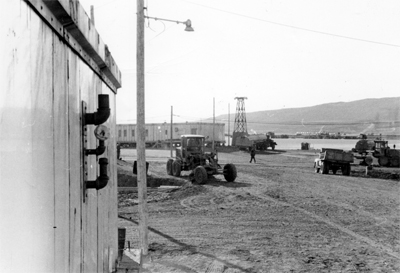
So when I finished my tour there, I was sent to Dover, Delaware, to Dover Air Force Base. I worked in a flight line office and then I was discharged in September, 1954.
(Rexanne asked specific questions of Wes to trigger some more memories of his military days.)
Rest and Recuperation (R&R): "I never took a 3-day Pass all the time I was in there. I didn't really need one. I couldn't get that far anyway, because I was more than a 1000 miles away from home."
Communication/letters home: "Our mail service was real good. In fact our mail service to Greenland was almost better than it is right here. We were able to make phone calls, but I never made any. I just didn't spend money for those things."
Food: "I couldn't complain about the food. The food was always pretty good."
Supplying the Greenland Base: "To get supplies to the Greenland Base, they would send an ice breaker up the Bering Strait (which connects the Bering Sea with the Arctic Ocean) between Russia and Alaska. Along about the latter part of June, the ice would soften enough so they could break a path so the ships could come in. Because all the fuel that was used to fuel the planes so they could get back had to be brought in by ship. They were able to move ships in during July, August and early September. All supplies used on the base, including all of the food, were brought in by ship during the short time span. So it was no wonder that some of the food began to have an odor and an "old" taste before a new year rolled around. But for the most part, they took good care of us."
Number of men on base: "I don't know how many men were on the base. It was huge. The Army was also there with us. They were supposed to guard us in the air. We had one helicopter crash and lost 6 men. We had one guy walk into the propeller of an airplane. And we probably had one or two that probably froze to death when they got out into the storms and got lost.
What did you do on base? (especially during those 4 dark months): If it wasn't storming, we would have to get out and do minor maintenance on the air craft that were outside. We would only work an hour or so, because it took so much to heat those big hangars. If an airplane came in and was going to be there longer then 8 hours, auxiliary heat had to be put on those engines to get them warm enough to start them. That usually took 8 hours. I didn't have anything to do with the electrical power, but I imagine they had generators somewhere.
Greenland temperatures: "The coastline would clear during the summer - it would thaw out. In between the mountains and the valleys, you would see some tundra (a vast, treeless arctic plain). That was the only thing that grew up there, although you would see a few little flowers that grew about two inches tall and would get a blossom on it. I think it was about seven miles from the base and you would come to the ice cap that covers the whole country of Greenland. And we had one radar site sitting on ice that was 7000 feet thick. It never thaws on a Greenland ice cap in that area. It stays frozen year round. I'm not sure just how big Greenland is, but I think it is too small to be a continent. Denmark owns Greenland. There was one village close to us called Thule and it was off limits to us because it was for the Eskimos. There was only the air base and the one small village as far as settlements were concerned. There were no towns, no roads, no nothin'."
Eskimos: "I really don't know too much about the Eskimos but they must have been able to fish and catch seals cause they lived off the land. You've probably seen pictures of little Eskimos kids in their furs. And that's actually the way they are. And, of course, they had their dogsleds for transportation. I never saw a polar bear. It may have been too far north for them because there is nothing out there for them to eat. And that ocean is froze over most of the time."
Frozen Ice Island:We had a frozen ice island and it was called T-3. It was something like 2 1/2 x 3 miles in size. As part of the Air Force, we had an attachment of weathermen that were living on that floating island in the Arctic Ocean. The winds and shifting ice kept that ice island moving around. When we would try to fly in supplies for them, we would have the location pin-pointed on our map and when we would get there sometimes the island wouldn't be there and we would have to go home again. They would get a fix on it again with the radio and we would try again."
Ice Shelves: "When they talk about the ice shelves in Antarctica, I know just exactly what they are talking about. The ice on the ice caps is constantly moving, very slowly. It will come down off the slopes of the land and gets out there far enough, that eventually it moves out over the ocean and then breaks off. Actual ice rivers are called fiords. And that's where the icebergs come from. They break off of these ice rivers."
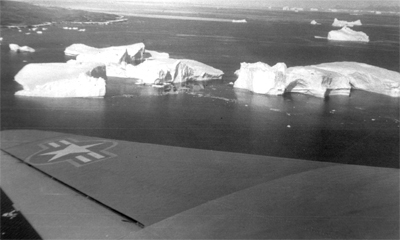
Ice breakers: "You've probably seen in the papers, from time to time, where they talk about the East Wind. That's the name of that ice breaker. And it's interesting how they do that. They'll cut through the ice until they can't go any further. Then they will back up and ballast the water from the front end of the ship to the back end to get the front end up. Then they'll hit that ice and push the water towards the front and down it comes and breaks through a little farther. Usually salt water doesn't freeze but in this area the ice might be 17 to 18 feet thick."
On duty: "We worked 12 hour days, seven days a week (on base in Greenland) at the aircraft hangar because we had planes coming and going all the time. It was better to stay busy than not have anything to do. For entertainment we had movies - we couldn't leave the base. We played a lot of cards."
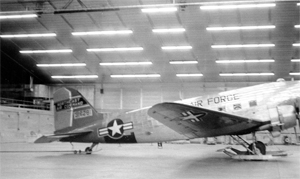
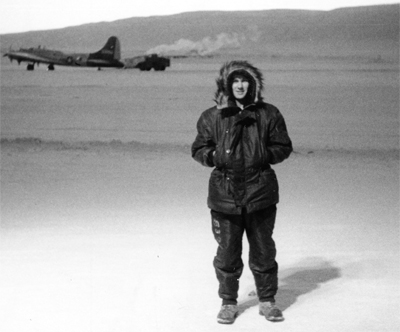
Other personal history: "I grew up in Manning. Then in my junior year, my folks bought a farm near Charter Oak. I attended Charter Oak high school my last two years. My folks never liked it there and they moved back to Manning. My Dad's name was Alfred and Mom's name was Anita. She was from around Halbur. Dad and Mom always farmed. They farmed my grandpa Bill's farm which has been in the family since the 1880s. My granddaughter lives on the farm now.
I had thought that I might make the Air Force my career, but in the end decided to return to Manning to farm. I was an only child and the farm was there for me. In 1956, I married Rosie Muhlbauer, my high school sweetheart."
"I spent all of my time in the Air Force on the east coast and in Greenland and never came close to going to Korea that I know of. I think the Greenland base is closed, as far as I know. Although there might be some scientists working at the base now. The early warning system is gone now, too. That is all done by satellites now. I don't think any of that is being used. And I know Bill Ranniger was down to the Turk Islands in the Caribbean and they were at that island that I flew in and out of, and they said that was all rotted down. The government had spent tremendous amounts of money, and there it goes.
I flew in and out of the Bahamas, Turk Islands, and San Salvador. That is where Columbus supposedly landed the first time. They had a monument there for him.
We also flew into Cuba. (Some of the pilots had to go over there quick and get their whiskey). Fulgencio Batista was in power at that time and it was a mixed up country then already.
There was a naval base there - Guantanamo Bay.
I was also in Goose Bay, Labrador, which is located in central Newfoundland. We passed thru there on our 12 hour flight from Newfoundland to Greenland in an old WWII plane. Everything was froze up when I went, so the only way up there was by air. We didn't have any cargo planes, just fighter planes and then pretty soon they started coming with a few bombers with jet engines.
Did you ever hear about the two bombers that collided and crashed over Irwin back in 1955 or 56 or 57? (Note information below about collision) That was one of our first bombers - a B47. That was quite a plane, too. Then pretty soon they came out with a B36 which had ten engines on it - 6 propeller engines and four jet engines. (Early 50s) Then after that came the big B52s in the late 50s. I never did see a B47 up close because they were under high security at the time because they were bombers.
We were on our way home from Yellowstone National Park when the B47s collided over Irwin and we heard about it over the radio. They were on a training mission and two of them ran together. I don't know how many days it took to round up the bodies. They had to search the corn fields. It was scattered north of Irwin.
I remember when Kenny Jensen went to the Army. It was on the tail end of the war and I think he was in the group that was training to invade Japan. When the war was over, he came back and finished high school. Him and Kenny Pfannkuch. They were in their senior year, when I left here. They were that much farther ahead than I was.
Describing planes: "All of the planes in the arctic were painted with red tails and red wing tips. And that was so they could find them if they went down for some reason. Some of the planes had skis attached so they could land on the Greenland ice cap."
Must be
looking at pictures??
"This is a picture of the supply area at the Thule Air Base. You can see
what the area looks like. There isn't anything there."
Building construction on Thule Air Base: "The buildings were all built about 4 foot up off the ground so the air could go through it. The reason for that was so the permafrost wouldn't thaw out from under the buildings (permafrost is when the land is continuously froze). Our air craft hangars had refrigerated floors in them so they wouldn't thaw out the ice underneath the buildings. If it started to thaw, the buildings would start to shift, sink or break. The buildings that were built up off the ice were weighted down with slabs of cement to keep them from sliding or shifting.
Every building was equipped with its own water and sewer system, and everything had to be hauled by truck to or from these buildings. So you can imagine what kind of a work force it took to run that place. As far as I know, the sewage was disposed of in the ocean. Our drinking water came from a lake up by the Greenland ice cap. Evidently they could get under the ice far enough to pump the water. The water was pure because of the terrific cold weather all the time. I don't think they ever put chemicals in it and the water was GOOD.
The Thule Air Force Base was under construction when I was assigned there. The government had hired civilians to do the work. They made tremendous amounts of money. If they committed to an 18 month contract, their wages were tax free."
Wes' reference to collision over Irwin, Iowa above
Source - Internet
August 19, 1963 Two Boeing B-47 Stratojets of the
40th Bombardment Wing from Schilling AFB, Salina, Kansas, collide in mid-air
over Irwin, Iowa during a nine-hour navigation, air-refueling and radar bomb
scoring mission. Bombers depart Schilling at 1125 hrs. and
1126 hrs., then collide in overcast shortly after 1230 hrs., coming down on two
farms ~2 miles apart. Two crew DOA at Harlan Hospital, Irwin, Iowa, three
treated for injuries, one located alive. Strategic Air Command identifies three
survivors as Capt. Richard M. Smiley, 29, of Arlington, Kansas, aircraft
commander of one B-47; Capt. Allan M. Ramsey, Jr., 32, of Bainbridge, Georgia,
Smiley's navigator; Capt. Richard M. Snowden, 29, navigator on second B-47.
Listed as missing: Capt. Leonard A. Theis, 29, San
Fernando, California, co-pilot on second B-47; dead is Capt. Peter J. Macchi, 29, Belleville, New Jersey, Smiley's co-pilot; second
fatality not immediately identified. Smiley suffers head injuries, Ramsey, back
injuries, and Snowden, burns and leg injuries.
Visitation Friday, March 5, 2021 AT 9:30 AM - 10:15 AM Sacred Heart Church - Manning, Iowa
Mass of Christian Burial is Friday,
March 5, 2021 ~ 10:30 AM at Sacred Heart Church, Manning
Reverend Randy Schon is the Celebrant.
Lector is Jim Muhlbauer
Recorded Music "Amazing Grace" "How Great Thou Art" "Be Not Afraid" "Air Force Song"
Honorary Bearers are Wes's Grandchildren: Grant Nulle, Shannon Lenaghan, Jamie Blum, Bryce Irlbeck, Rachel Nulle, Natalie Hanson, Andrea Nulle
Interment at Sacred Heart Cemetery, Manning
Military Honors by United States Air Force Honor Guard Veterans of Foreign Wars Post 3517
American Legion Post 22
Wesley Gene, son of Alfred and Anita (Schroeder) Nulle, was born September 2, 1930, at Manning, Iowa. He attended Iowa No. 7 and Hayes No. 9 country schools, and then attended Manning High School. The family moved to Charter Oak where he graduated from Charter Oak High School in 1949.
On December 26, 1950, Wes enlisted with the United States Air Force. He first served in Texas at Lackland Air Force Base, and then served at Sheppard Air Force Base where he trained in aircraft mechanics. He then received rocket training at Chanute Air Force Base in Illinois and Patrick Air Force Base in Florida. For a short time, Wes was assigned to a C-54 making trips to the Caribbean Islands. Finally, he served on a C-47 at Thule Air Base in Greenland, hauling supplies for the DEW line, a radar system that stretched across northern Canada. Upon receiving his honorable discharge in September of 1954, Wes returned to Iowa and started farming.
On September 10, 1956, Wes was united in marriage with Rose Anne Muhlbauer at Sacred Heart Church in Manning. Four children were born to this union. The couple rented a farm northwest of Botna for 7 years and then they made their home on the family farm southwest of Manning for nearly 40 years. The farm has been in the Nulle family since 1893.
After their retirement from farming in 1994, the couple moved into Manning. Wes and Rose Anne enjoyed spending 17 winters in the far south of Texas. Over their married life they traveled through most of the United States and several countries in Europe, including a visit to family in Germany. During his retirement, Wes delivered motor homes for Winnebago throughout the United States and Canada.
Wes was a member of Sacred Heart Catholic Church, the Veterans of Foreign Wars Post 3517 and the American Legion Post 22. Wes enjoyed fishing and playing cards with his friends and family, especially his brothers-in-law.
After Rose Anne passed away on October 7, 2011, Wes continued living in their home in Manning until June of 2016, when he became a resident of what is now Manning Senior Living.
On Wednesday, February 10, 2021, Wes passed away at Manning Regional Healthcare Center in Manning. He was 90 years, 5 months, and 8 days of age.
Besides his wife Rose Anne, Wes is preceded in death by his parents; son Duane in infancy; brothers-in-law and sisters-in-law: Charles (Ann) Muhlbauer; Joe (Erna Odendahl) Muhlbauer; Sophia (Wayne) Kuhse; Henry "Hank" (Ruby) Muhlbauer; Anthony "Tony" (Laura) Muhlbauer; Marie (Vic) Wendl; brothers-in-law William "Bill" and Louis "Louie" Muhlbauer.
He is survived by his children: Mark (LuAnn) Nulle of Gillette, Wyoming; Theresa (Brian) Irlbeck of Manning; and Lynn (Sonia) Nulle of Manning; grandchildren: Grant (Christina) Nulle, Shannon (Jason) Lenaghan, Jamie (Jeff) Blum, Bryce Irlbeck, Rachel Nulle, Natalie (Mitchell) Hanson, and Andrea Nulle; 10 great-grandchildren; and sisters-in-law Iola Muhlbauer of Manning and Phyllis Muhlbauer of Manilla, as well as other relatives and friends.